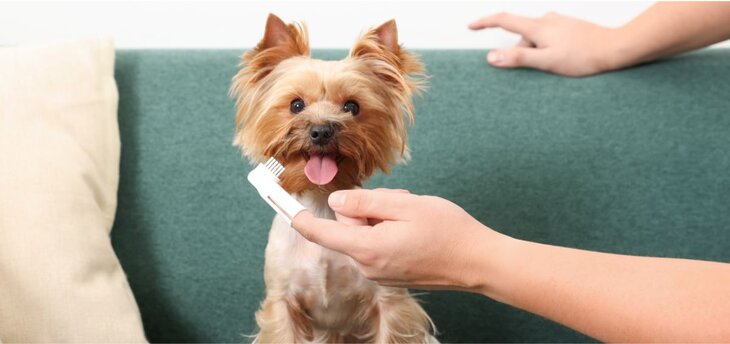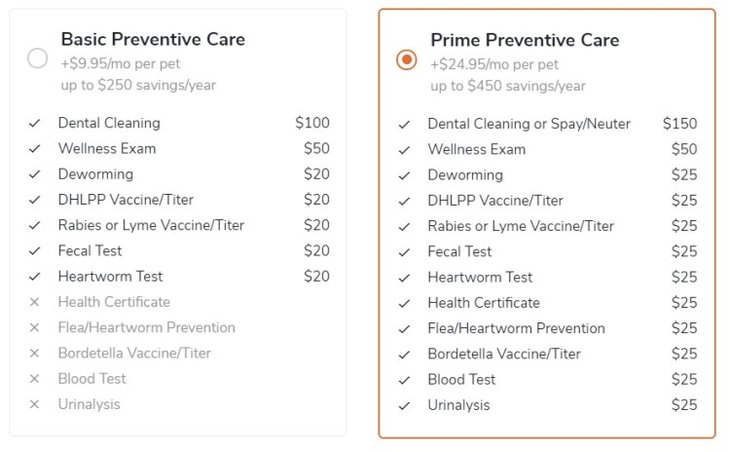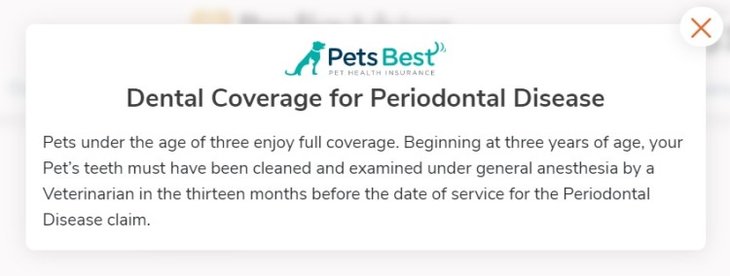Does Pet Insurance Cover Dental?
Reviewed by Kari Steere, Licensed Insurance Producer
Updated: Jun 25, 2025
When we think about covering veterinary costs for our pets, we’re usually thinking about routine checkups, vaccinations, and the costs of treatments for serious illnesses or accidents. But just like humans, dental care is an important part of maintaining our pet’s overall health.
Key Takeaways
- The cost of treatment for most pet dental issues can be very expensive without insurance.
- Many pet insurance plans include coverage for treatments related to oral injury and dental disease in pets, but coverage for routine cleanings usually falls under a separate preventative care plan.
- Pet insurance companies do not provide coverage for pre-existing conditions, such as gum disease, which affects two out of three pets by age three, so it's best to enroll your animal as soon as possible.
- Pawlicy Advisor can help you compare pet insurance plans from top providers to find the best fit for your needs.
Find pet insurance with dental coverage at Pawlicy Advisor.
Dental disease in dogs and cats can be just as serious as any other illness. If left untreated, bad oral hygiene can lead to dental disease, infection, tooth loss, and malnutrition. Unfortunately, this often happens because dental treatments at the vet can be very expensive.
Many owners choose to defer the cost of routine dental cleanings and allow the problem to slowly worsen over time, leading to more expensive treatments down the road. Some dental treatments can cost over $1,000, so you might want to consider getting dental coverage as part of your pet insurance plan.
Pet dental procedures can cost over $1,000
Here’s what you need to know about pet dental insurance and how to find gold star coverage for your pet.
Table of Contents:
- Does Pet Insurance Cover Dental?
- How does cat and dog dental insurance work?
- Best Pet Dental Insurance Plans
- Which pet insurance companies cover dental treatment?
- Why do I need dental insurance for my pet?
- What is a pre-existing condition?
- What dental treatments are covered by pet insurance?
- What dental treatments are excluded by pet insurance?
- How do you add pet dental insurance?
- How To Choose Dental Insurance For Your Pet?
- How can you save money on pet dental care?
- Key Takeaways
- Frequently Asked Questions
Does Pet Insurance Cover Dental?
Pet insurance can cover dental procedures like extractions, crowns, and gum treatments, as long as the problem shows up after you enroll and your pet meets the exam requirements. Routine cleanings aren’t included in standard plans, but you can get coverage for them by adding a wellness package. Cosmetic dental work and pre-existing conditions won’t be covered, no matter what. To avoid surprise costs later, it’s smart to enroll your pet early and carefully read the policy details.
How does cat and dog dental insurance work?
Unlike human healthcare, pet dental insurance is not sold separately; rather, it's included as a feature within most traditional pet insurance plans. In most cases, owners pay a monthly fee toward their annual premium and receive reimbursement for a certain percentage of unexpected vet costs once they've met their deductible.
Note that not all pet insurance plans cover the cost of dental treatments, nor are all treatments covered, so it's important to carefully compare the details of each policy to ensure you find the right solution.
Pawlicy Advisor makes it easy to search for pet insurance that includes dental coverage, but remember to carefully read through policy details to know whether it's included elsewhere.
Best Pet Dental Insurance Plans
Pet dental problems are common, painful, and expensive, but the right insurance plan can help cover the cost. We’ve reviewed the top providers to help you find the plan that bites down on costs without sinking your budget.
ASPCA Pet Health Insurance
Strong all-around dental protection, especially for injuries and illness.
ASPCA offers one of the most flexible pet insurance plans on the market. Their Complete Coverage plan includes treatments for dental diseases, extractions, fractured teeth, and even gum disease, as long as issues occur after enrollment and meet exam requirements.
Bonus: Preventive dental cleanings have coverages available if you add the wellness rider.
Customer feedback: Pet parents praise ASPCA’s fast claims processing and “no surprise” reimbursements.
Hartville Pet Insurance
Same great coverage as ASPCA.
Hartville is actually underwritten by the same provider as ASPCA, which means their dental benefits are nearly identical. You’ll get coverage for non-routine dental treatments, including crowns, root canals, and tooth extractions.
Pro Tip: Choose the preventive add-on to help with your pet's cleaning expenses. These plans offer a max reimbursement of $150 toward dental cleaning so there will definitely still be out of pocket costs.
MetLife Pet Insurance
Stand out for value and speedy claims.
MetLife covers dental illnesses and injuries, such as abscessed teeth, broken teeth, and gingivitis. Their plan includes a fast 10-day reimbursement window and no upper age limit—a major perk for senior pets.
Bonus: Multiple-pet discounts and customizable coverage options.
Customer feedback: “MetLife Pet’s online claim submission was simple, and I had no problems getting the claims covered.”
Fetch
Most comprehensive dental coverage on the market.
Fetch covers every adult tooth for injury and disease, not just the four canines, unlike some plans. If your dog needs a root canal or oral surgery, it’s included. However, prescription dental diets are generally not eligible for reimbursement.
Fetch's core plan doesn't have a specific annual limit solely for dental coverage; rather, covered dental issues fall under your overall annual limit. This robust coverage makes Fetch an ideal choice for pet parents prioritizing deep, comprehensive dental protection for their furry friends.
Customer feedback: “Easy to begin a claim. Response was quick.” - Verified user
Pets Best
Best budget-friendly dental option with flexible add-ons.
Pets Best includes dental coverage for injuries and non-routine care, like tooth fractures, extractions, and abscesses. They also offer coverage for dental diseases in pets under 3 years old. Preventive dental cleanings aren’t included in standard plans, but you can easily add a wellness rider for routine care.
Bonus: Some of the lowest monthly premiums in the industry.
Customer feedback: Customers love the online portal and easy policy customization.
Which pet insurance companies cover dental treatment?
Most pet insurance providers offer some form of dental coverage for dogs and cats, but every plan is different. You can find pet dental coverage plans from all of the insurance companies that partner with Pawlicy Advisor, including:
Why do I need dental insurance for my pet?
According to Tufts University, about 80% of dogs and 70% of cats over the age of three show signs of oral disease by the time they are three years old.1 This widespread prevalence at such a young age presents a cost risk to insurance providers, which is why they often limit or deny dental coverage. For example, they typically set a maximum reimbursement rate, exclude coverage for specific treatments, and deny claims pertaining to pre-existing conditions.
What is a pre-existing condition?
A pre-existing condition in pet insurance means any health condition a pet has before coverage begins. This condition may result from illness, accidents, or hereditary traits, and encompasses both short-term and long-term health issues.
It's important to note that no pet insurance policy covers pre-existing conditions, meaning you cannot be reimbursed for those related expenses (although you should still enroll to receive coverage for other health concerns that might arise due to accident or illness in the years to come).

That's why it's critical to sign up for dog insurance or cat insurance while they're young, before they can develop dental diseases or other health problems that could require expensive treatments, medications, and vet visits over the course of their lifetime.
What dental treatments are covered by pet insurance?
You can find many plans that include pet dental insurance for issues such as:
- Dental injuries (broken, chipped, and fractured teeth)
- Tooth extractions
- Root canals and crowns
- Gum disease (gingivitis and periodontitis)
- Stomatitis
What dental treatments are excluded by pet insurance?
Routine teeth cleanings are considered preventative care, so they typically do not qualify for coverage under traditional accident/illness plans. However, most pet insurance providers offer supplemental pet wellness plans that can reimburse you for cat or dog dental cleaning costs.
Some companies may have coverage requirements based on your pet’s age. For example, pets over the age of 3 with Pets Best require annual dental cleanings in order to maintain certain dental disease coverages. Some companies may require a vet to perform an oral inspection to identify existing health concerns when enrolling pets of all ages. Pet insurance will never cover pre-existing conditions nor cosmetic procedures that aren’t deemed medically necessary for your pet’s health.
The best approach is to sign up for a plan early in your pet’s life to ensure they are covered for any illnesses that may occur, oral or otherwise.
How do you add pet dental insurance?
Most of the best pet insurance providers include dental treatment related to accidents and illnesses that occur after the policy goes into effect by default. Always check policy specifics if you have questions or use a comparison tool like Pawlicy Advisor. For routing dental care within your pet dental insurance plan, you'll typically need to add a preventative care plan.

You can find these by clicking on the insurance provider you are interested in a quote on Pawlicy Advisor.
Here’s an example of some ASPCA Pet Health Insurance routine care add-on options for a plan for a two-year-old dog:
ASPCA Pet Health Insurance plans offer generous coverage for dental issues, but you’d need to sign up for one of their Preventive Care options if you want pet insurance that covers dental cleaning. Otherwise, you’ll have to pay for these expenses out of pocket.
How to Choose Dental Insurance for Your Pet
Pawlicy Advisor makes it easy to find the best dental insurance plan for pets. That’s because we’ve read all the fine print on top providers’ policies, so you don’t have to.
When shopping for a pet insurance plan on Pawlicy Advisor, you can view each policy’s covered items and exclusions simply by clicking on a quote. If you want to see what types of dental treatments are covered, just scroll down to the “Dental” section.
Below is an example of the dental coverage provided by a Pets Best insurance plan for a two-year-old dog:

As you can see, the plan covers tooth extractions and illness-related cleanings without any stipulations.
Tooth extractions are one of the most common pet dental health procedures conducted by veterinarians, and the cost of dog tooth extractions can vary depending on the complexity and your vet’s pricing. They might be necessary if your pet has loose teeth or tooth fractures, which have been reported in up to 49.6% of companion animals according to the AAHA.2 The dental procedure itself is often simple, but it may require anesthesia, which can increase the cost.
The Pets Best plan also covers "Illness-Related Cleanings", non-routine dental procedures your veterinarian may recommend if your pet has a dental or oral illness. These cleanings, often called therapeutic, advanced, or periodontal cleanings, are performed when a pet has active dental disease. They go beyond cosmetic or preventive care and are necessary to treat painful oral conditions such as infection, tooth loss, or other pathological issues.
But the remaining items, “Dental Coverage for Periodontal Disease” and “Dental Coverage for Deciduous Teeth, Cysts, Enamel, and Unerupted Issues,” are only covered sometimes. You can learn more about the conditions of coverage by clicking on “Click for More”.

Under this Pets Best plan, pets under the age of three get full coverage for periodontal disease, a common gum disease that damages gums, which can then extend to the jawbone, leading to tooth loss.
However, if your pet is over the age of three, you can only receive reimbursement for treatment costs if your pet has received a dental cleaning under general anesthesia within 13 months of the claim's date of service. This is why it’s so important to take your pet in for regular dental checkups.
Similarly, this Pets Best plan will only cover tooth extractions for periodontal disease if your pet was enrolled prior to six months of age. Although the plan lists “Dental Coverage for Tooth Extractions” as “Covered,” this is an exclusion to be mindful of.
Pets Best is just one of the brands you can get pet health insurance from through Pawlicy Advisor.
How can you save money on pet dental care?
Most veterinarians recommend dogs and cats receive dental cleaning during their annual checkups, and the cost of a dental cleaning for cats may surprise many pet parents. This will help your vet identify the first signs of health issues and ensure your pet is at a lower risk of contracting costly dental diseases later in life.
You can also take care of your pet’s dental health by brushing their teeth regularly. According to VCA Animal Hospitals, you should brush your dog's teeth twice per day or a minimum of three times per week.3 They recommend the same schedule for cats.4
Dental hygiene treats and chews may also help maintain your pet’s oral health between cleanings.
In the meantime, use Pawlicy Advisor to search for a pet health insurance plan that provides dental coverage. Don’t forget to check the coverage details under each quote. You can also use Pawlicy Advisor to compare plans side-by-side, helping you find the best dental coverage for your furry friend..
Compare Top Pet Insurance Companies Side-by-Side
Use Pawlicy Advisor to get personalized quotes from leading brands and see how each plan stacks up — instantly.
100% free to use. No fees. No commitment.
Frequently Asked Questions
How much does dog dental cleaning cost?
Costs for dog teeth cleanings depend on a number of factors, including the condition of your pet's oral health and the rates of your veterinarian's practice.
How often do I need to get my dog's teeth cleaned?
Vets recommend professional dental cleanings for dogs once a year as part of a routine care plan. This helps ensure your veterinarian can detect the onset of gum disease early on and recommend a treatment plan before it significantly worsens.
Are routine teeth cleanings included in pet insurance?
Most of the time, dental cleanings for dogs and cats are considered preventative care and, therefore, do not classify as coverage under traditional accidental/illness pet insurance plans. However, most pet insurance providers offer supplementary pet wellness plans you can add on for extra coverage, including the cost of routine dental cleanings.
How often should I brush my dog's teeth at home?
It's a great idea to brush your dog's teeth at home to prevent plaque and tartar build-up. This helps them maintain good oral hygiene and minimizes the deep cleaning required during annual dentistry, which can be uncomfortable.
Does pet insurance cover dental care?
Some, but not all, pet insurance plans cover dental treatments related to illnesses, such as tooth infection and gum disease, as well as dental injuries due to accidents. However, no pet insurance covers pre-existing conditions, including dental diseases that are known to develop in 80% of dogs and 70% of cats by age three. That's why it's important to enroll in pet insurance while your animal is young.
Looking to save on vet bills? See which pet insurance is right for you.
Instant results. 1M+ pet parents served.
⭐⭐⭐⭐⭐ 4.9 stars across hundreds of reviews.
See which pet insurance is right for your best friend.
Do you want to find the best pet insurance?
Let's analyze your pet's breed, age, and location to find the right coverage and the best savings. Ready?
Analyze My PetAbout Pawlicy Advisor
The pet insurance marketplace endorsed by veterinarians, at Pawlicy Advisor we make buying the best pet insurance easier. By comparing personalized coverage and pricing differences we can save you a ton of money, up to 83% in some instances!
Instantly Compare Pet Insurance Plans
Guides
Determine If Pet Insurance Is Worth It
Comparison Charts
Find Your State
Dog Insurance
Pawlicy Advisor is the #1 pet insurance marketplace in the U.S. Recommended by veterinarians. Trusted by 1M+ Americans. Our team of veterinary advisors and licensed insurance experts are dedicated to helping pet parents give their dogs and cats the best possible care.
